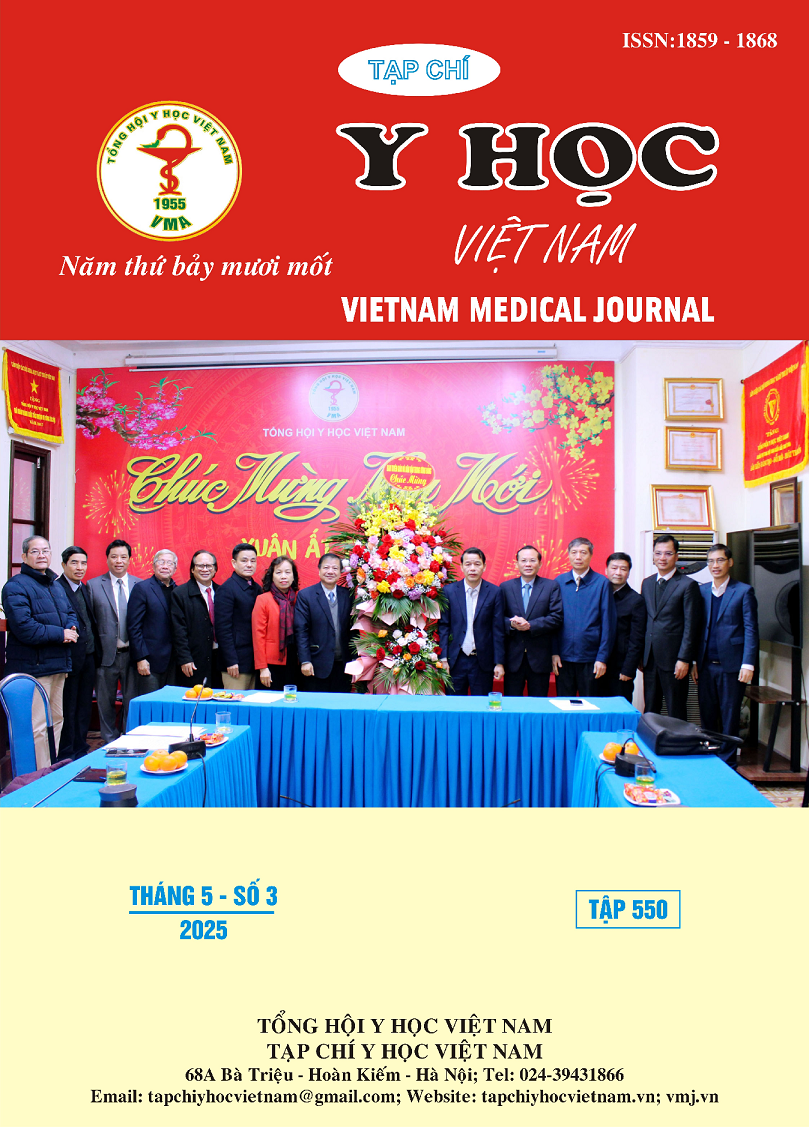STUDY ON CLINICAL AND PARACLINICAL CHARACTERISTICS OF ISCHEMIC STROKE PATIENTS WITH INTERNAL CAROTID ARTERY LESIONS AT MILITARY HOSPITAL 110
Main Article Content
Abstract
Objective: To describe the clinical and paraclinical characteristics of ischemic stroke patients with and without internal carotid artery lesions. Research method: A prospective, cross-sectional and comparative study. Study subjects: 124 patients diagnosed with ischemic stroke who underwent 64-slice CT scanning and were treated at Military Hospital 110 from February 2018 to May 2019. Results: The average age of patients with anterior circulation stroke was 66.84 ± 12.30 years, with males accounting for 69.4%. A history of previous stroke was observed in 23.3% of patients with internal carotid artery lesions, higher than the 6.2% in the group without lesions. The group with internal carotid artery lesions had more severe paralysis, with 51.2% of patients having a muscle strength score of 1/5 upon admission. The average Glasgow score in the group with internal carotid artery lesions was 12.98 ± 1.67, lower than the 14.36 ± 1.15 in the group without lesions. The NIHSS score was higher in the group with internal carotid artery lesions, averaging 12.91 ± 5.95 compared to 6.64 ± 3.30 in the group without lesions. The ASPECT score was lower in the group with internal carotid artery lesions, with an average of 7.16 ± 1.70 compared to 8.69 ± 1.19 in the group without lesions. Conclusion: Anterior circulation ischemic stroke is more common in individuals over 60 years old and predominantly affects males. Patients with internal carotid artery lesions experience more severe paralysis and greater consciousness impairment than those without lesions. Regarding assessment scales, the NIHSS score is higher, and the ASPECT score is lower in the group with internal carotid artery lesions compared to the group without lesions.
Article Details
Keywords
Ischemic stroke, internal carotid artery lesion
References
2. Lee S. J., Cho S. J., Moon H. S., et al. (2003). Combined extracranial and intracranial atherosclerosis in Korean patients. Arch Neurol, 60(11): 1561-4.
3. Ralph L. Sacco, D. E. Kargman, Qiong Gu, et al. (1995). Race-Ethnicity and Determinants of Intracranial Atherosclerotic Cerebral Infarction. Stroke, 26(1): 14-20.
4. Ka Sing Wong, Huan Li, Yu Leung Chan, et al. (2000). Use of Transcranial Doppler Ultrasound to Predict Outcome in Patients With Intracranial Large-Artery Occlusive Disease. Stroke, 31(11): 2641-2647.
5. Caplan L, Gorelick PB, Hier D B (1986). Race, sex and occlusive cerebrovascular disease: a review. Stroke, 17(4): 648-655.
6. Adams H. P., B. H. Bendixen, L. J. Kappelle, et al. (1993). Classification of subtype of acute ischemic stroke. Definitions for use in a multicenter clinical trial. TOAST. Trial of Org 10172 in Acute Stroke Treatment. Stroke, 24(1): 35-41.
7. Hoàng Văn Thuận (2013), Tai biến mạch máu não, in Bệnh học thần kinh, Giáo trình sau đại họcNhà xuất bản Y học, Hà nội, 15- 30.
8. Schellinger P. D., Thomalla G., Fiehler J., et al. (2007). MRI-based and CT-based thrombolytic therapy in acute stroke within and beyond established time windows: an analysis of 1210 patients. Stroke, 38(10): 2640-5.
9. Mai Duy Tôn (2012), Đánh giá hiệu qủa điều trị đột quỵ nhồi máu não cấp trong vong 3 giờ đầu bằng thuốc điều trị tiêu huyết khối đuờng tĩnh mạch Alteplase liều thấp, Truờng Đại Học Y Hà Nội.
10. Kang D. W., Sohn S. I., Hong K. S., et al. (2022). Reperfusion therapy in unclear-onset stroke based on MRI evaluation (RESTORE): a prospective multicenter study. Stroke, 43(12): 3278-83.


